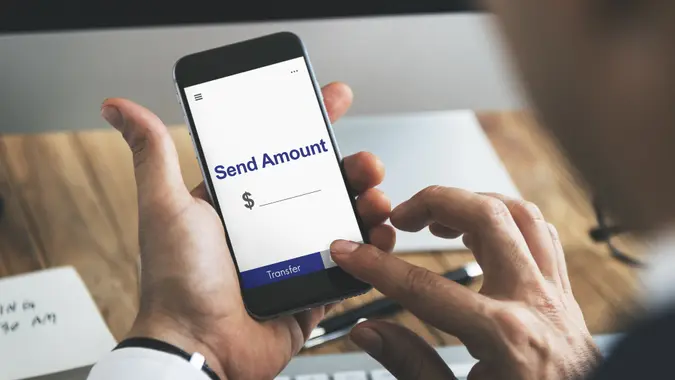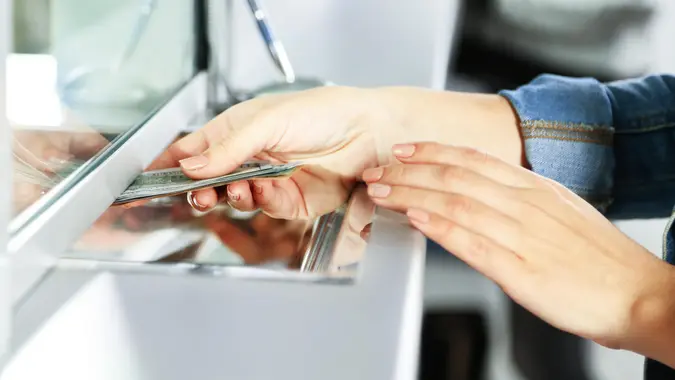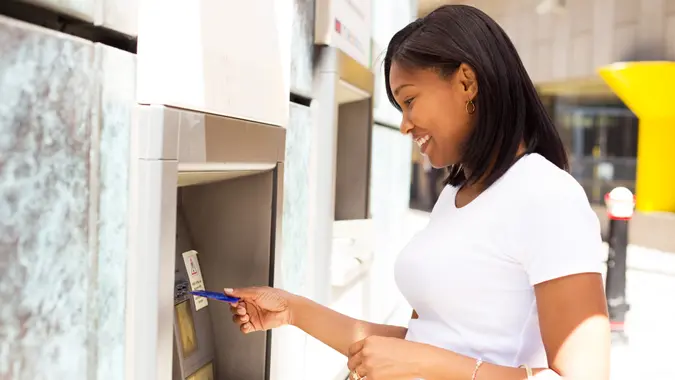What Is ATM Skimming and How Does It Work?

Commitment to Our Readers
GOBankingRates' editorial team is committed to bringing you unbiased reviews and information. We use data-driven methodologies to evaluate financial products and services - our reviews and ratings are not influenced by advertisers. You can read more about our editorial guidelines and our products and services review methodology.

20 Years
Helping You Live Richer

Reviewed
by Experts

Trusted by
Millions of Readers
If you think about how much personal information you have floating around online, it’s enough to make anyone uneasy. Whether you’re pulling cash from an ATM or shopping online with your credit card, you could be at risk for theft. One threat to be aware of is ATM skimming. So, what is ATM skimming — and how can you avoid becoming a victim?
What Is ATM Skimming?
ATM skimming is a type of fraud where thieves install hidden devices on ATMs to steal your card information. Typically these devices copy your data from the magnetic strip on your card when you insert it into the ATM slot.
Thieves place a hidden camera near the keypad or keypad overlay to steal your PIN. Using your card data and PIN, thieves can make fake copies of your card. They will use this counterfeit card to withdraw cash and make unauthorized transactions.
How Does ATM Skimming Work?
Criminals don’t have to do much to steal your ATM number and PIN. Typically thieves will place a skimming device over the real card slot.
- When you insert your card, the skimmer will read and save your card information.
- A small hidden camera — usually placed by the keypad — will record your PIN when you type it.
- In certain instances, a fake keypad can be used to read the PIN directly.
- When the thief has your account number and PIN, they begin withdrawing cash or making unauthorized purchases.
Signs an ATM May Be Compromised
How can you tell if the ATM you’re using is a thief’s target? Don’t ignore the following signs:
- Look at the card slot. If the slot looks loose, bulky or misaligned, steer clear of that ATM.
- Feel the keypad. If the keypad feels hard to press or seems too thick, don’t finish your ATM transaction.
- Eye the ATM. If the ATM has wires or parts sticking out, you don’t need further confirmation that it has likely been compromised. If the ATM looks mismatched or it appears parts have been added later, time to drive away and find a new ATM location.
Key Tip
If your gut tells you something is wrong with the ATM you’re using, trust your judgment and find a new ATM. You can save yourself from future headaches.
ATM Skimming vs. Card Cloning
Confused about ATM skimming vs. card cloning? Just remember skimming is how criminals get your data, while cloning is how they use it.
Take a look at this chart to learn more about the differences:
| Feature | ATM Skimming | Card Cloning |
|---|---|---|
| Definition | Thieves place hidden devices on ATMs to steal card details and PINs. | Stolen card data is copied to a new, counterfeit card. |
| How It Works | A skimmer reads the magnetic stripe, while a hidden camera or fake keypad captures the PIN. | Card details are obtained via skimming, data breaches or hacking, and then written onto a blank card. |
| Common Locations | Convenience store ATMs, gas stations, outdoor ATMs and self-checkout machines. | Restaurants, gas stations, online transactions and data breaches. |
| How To Prevent It | -Use ATMs inside banks -Check for loose card readers -Cover the keypad -Enable bank alerts |
-Use chip cards or tap-to-pay -Monitor statements -Enable fraud alerts -Avoid swiping in suspicious locations |
How To Protect Yourself From ATM Skimming: 6 Easy Ways
Even if you know how to detect a credit card skimmer, it’s better to avoid situations where you’re likely to encounter a skimming device. Here are six ways to protect yourself from ATM skimming:
1. Use Indoor ATMs
ATMs inside banks can be easily monitored. It is difficult for thieves to tamper with the ATM when they know they’re being monitored.
2. Cover the Keypad
It may seem like one more step, but covering the keypad while entering your PIN can be a lifesaver if prying eyes are watching.
3. Check the ATM
If the ATM has loose parts or seems suspicious, trust your instincts. Make the effort to go to a different ATM location.
4. Sign Up for Alerts
You’re likely already on your phone, so why not sign up for text bank alerts? Your bank will notify you immediately via text if there is a suspicious charge on your account.
5. Use Trusted Locations
Your chances of being skimmed will decrease if you use trusted ATM locations, preferably inside your bank.
6. Consider Contactless Payments
Many retailers allow for contactless payments so you can use your phone instead of a debit or credit card to pay for your transaction. The less you swipe, the more likely you avoid becoming a skimming victim.
What To Do If You Think You Used a Skimmed ATM
Do you think you’re the victim of skimming? You should act fast. Here are the steps you need to take immediately:
- Contact your bank ASAP and explain that you think your card may have been skimmed.
- Ask the bank to freeze your card and request a replacement.
- Monitor your account for suspicious transactions.
- You may want to reach out to the credit bureaus to place a fraud alert on your credit report.
How Common Is ATM Skimming?
In 2023, nearly 1,600 skimming events were identified. On average, 199 cards were skimmed per event. The good news is that ATM skimming is less common now because of chip cards.
Each time a chip card is used, a unique code is generated that is difficult to duplicate. However, machines that still rely on magnetic stripes are still susceptible to skimming.
Where Is Skimming Likely To Happen?
Generally skimming happens in stand-alone ATMs located in the following places:
- Gas stations. Gas stations are popular targets for credit card skimming devices, as criminals can easily compromise a gas pump card reader with a skimmer placed inside or out. They also place card-skimming devices on ATMs.
- Convenience stores. Stand-alone convenience stores are not necessarily monitored like bank ATMs. Skimmers can be installed without any detection.
- Tourist areas. Thieves know that sometimes tourists aren’t always traveling with cash. Tourists may need to get cash quickly from an ATM that isn’t necessarily monitored and is likely isolated. This is a perfect place for a skimmer to place a hidden camera or overlay.
FAQs About ATM Skimming
Here are the answers to some frequently asked questions about ATM skimming.- What is ATM skimming and how does it work?
- ATM skimming is a type of fraud where thieves place a hidden device on an ATM to steal your card information.
- A skimmer reads the numbers on your card's magnetic stripe while a hidden camera or keypad captures your pin.
- How do I know if an ATM has a skimmer?
- If the keypad feels off, there may be a fake overlay. Look for unusual attachments -- if the slot is loose, there may be a skimmer present. If the ATM is giving unusual errors, it may be compromised.
- Can ATM skimmers steal money from my account?
- Yes. If a scammer clones your card and gets your PIN, they can withdraw cash and make unauthorized purchases.
- Are chip cards safer from skimming?
- Yes, chip cards generate a unique transaction code that is hard to clone. However, if an ATM only reads the magnetic stripe, your card is at risk.
Barb Nefer and Caitlyn Moorhead contributed to the reporting for this article.
Our in-house research team and on-site financial experts work together to create content that’s accurate, impartial, and up to date. We fact-check every single statistic, quote and fact using trusted primary resources to make sure the information we provide is correct. You can learn more about GOBankingRates’ processes and standards in our editorial policy.
 Written by
Written by  Edited by
Edited by 
























